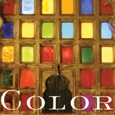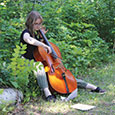
I have been making an effort to read more over the last six months. Sometimes I purchase a book on a recommendation from a magazine, and sometimes I browse Amazon.com for a topic to see what comes up. My favorite subjects to read about are astronomy and history, and occasionally this leads to some interesting recommendations from Amazon. One book that caught my eye was Simon Garfield’s Mauve: How One Man Invented a Color That Changed the World. I had no idea that mauve warranted a book (although I have since heard from an artistic friend that it is a fascinating story), but the idea of the history behind colors seemed suddenly interesting, so I ordered a different book of a more general nature: Color: A Natural History of the Palette by Victoria Finlay.
The history of color as it relates to humanity is primarily a history of trying to make colors, and the book is an account of Finlay’s travels to discover the story of both ancient and modern techniques. The chapter on orange is primarily the story of the varnish Antonio Stradivari used on his instruments. Il Cremonese, a 1715 Stradivarius violin on display in Stradivari’s hometown of Cremona is a brilliant example of this orange, with the back of the violin “boldly patterned like a tiger’s coat,” as Finlay puts it. Turning the violin or moving your head can make the pattern in the wood seem to wiggle.
The formula for this orange is unknown today, with experts not even able to come to a consensus over how many coats he used. One of the few clues we have is a letter written on August 12, 1708 from Stradivari to a patron. It includes the line, “I beg you will forgive the delay with the violins occasioned by the varnishing of the large cracks, that the sun may not re-open them.” Theories include saffron, dragon’s blood, madder, and copal, an expensive resin from the Americas. To complicate the matter, luthier Riccardo Bergonzi, a descendant of Carlo Bergonzi, considered Stradivari’s greatest pupil, hypothesized that Stradivari never made his varnish but rather ordered it based on what he thought would be right for each of his instruments.
Whatever the case may be, the one certainty is that color-makers can be extremely secretive. Copal was known to be one of the ingredients in a long-lasting amber-colored varnish manufactured in the early 18th century by a Parisian named Monsieur Martin, but the rest of the recipe was a closely guarded secret. The varnish was popular among the wealthiest members of society, and the Society of Arts and Sciences in London offered a prize to an Englishman who could make something similar. The requirements indicated that the varnish had to be “hard, transparent, of a light color, capable of the finest polish, and not liable to crack.” The test to be passed was for the varnish to be exposed to the elements for six months. Upon hearing this, Martin apparently laughed and declared he would retire if anyone invented something that could pass such a test.
Orange varnish is hardly the only case of an attempt to keep a secret. Carmine red today this is still used as food and lipstick coloring, but in the 16th and 17th centuries, it was in extremely high demand all over Europe as a dye. Originally developed by both Incas and Aztecs, the Spanish Empire managed to keep secret for more than a century that the color was made from cochineals, insects that live only on the underside of prickly pear cacti. In the late 18th century French botanist Nicolas-Joseph Thiéry de Menonville risked life and limb to sail from Haiti to Central America to learn the truth and break the story to the world.
Even black is not without controversy. In the 17th and 18th centuries, a graphite mine near Seathwaite, England was deemed valuable enough that the miners were strip-searched at the end of every shift to make sure no graphite was smuggled out, although to be fair, graphite’s value was also high because of its value to the war industry.
Although I understand and agree with the desire to keep a trade secret, I am grateful that such secretiveness is a rarity in music education. The topics vary widely, but each month our authors share what they’ve learned, whether the knowledge comes from years of practice and accumulated experience or simply the consequences of a mistake made.
This issue includes excellent advice for student teachers as well as extremely useful conducting and concert programming tips, along with ideas for setting some future goals and encouragement to keep working toward the highest standards as the spring semester begins.
One thing I’ve learned about wisdom is that it often comes in situations that are overlooked, whether this is having enough cash to be able to make change on the (surprisingly good) chance that the first three people to show up at a fundraising event only have a twenty dollar bill or remembering always to check an older instrument’s mouthpiece for spider eggs before putting it in your mouth. (I learned this the hard way.) If you have picked up some interesting, unusual, or helpful tidbits of wisdom over the years, drop us a line and share what you’ve learned. As I often share with authors, we are in the business of sharing ideas, and we would love to share yours, too.
Finlay’s book is not simply a story of secrets; there is plenty of wisdom to be found within. I will close with a quote from Pablo Picasso that I have been turning over in my mind for the past few weeks and suspect I will continue to ponder for quite a while yet, as I think it can apply to a great number of situations: “There are painters who transform the sun into a yellow spot, but there are others who, thanks to their art and their intelligence, transform a yellow spot into the sun.”
Best wishes for 2015.





